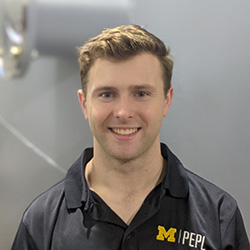
Ph.D. Student Will Hurley Awarded NASA Space Technology Graduate Research Fellowship
Hurley recognized for innovative space technology research with NASA funding

Hurley recognized for innovative space technology research with NASA funding

A prestigious NASA fellowship, the NASA Space Technology Graduate Research Opportunity (NSTGRO), was recently awarded to Aerospace PhD candidate Will Hurley for his proposed research on ultrahigh power density Hall Thrusters at the University of Michigan.
NSTGRO is a four-year NASA-sponsored fellowship that seeks to sponsor “graduate students who show significant potential to contribute to NASA’s goal of creating innovative new space technologies for our Nation’s science, exploration and economic future”. Awardees are also matched with a NASA subject matter expert to serve as a research collaborator and visit NASA centers for a few months each year to perform research and collaborate with NASA engineers.
“I am extremely excited and fortunate to be a recipient of the NSTGRO fellowship. I want to thank NASA for giving me this amazing opportunity to pursue my research goals. I also want to thank my lab mates and advisor for their support and guidance every day and during this application process,” says Hurley.
Hurley is a Ph.D. student in Prof. Benjamin Jorns’ group at U-M, the Plasmadynamics and Electric Propulsion Laboratory (PEPL). Hurley’s research supported by the fellowship is for the proposal “Development of an Ultra High Current Density Magnetically Shielded Hall Thruster”, outlining the plan to build a new Hall thruster, designed to operate steady state for >100 hours at ~100 kW of input power, at elevated current densities.
“My goal is to show that Hall thrusters, a type of space propulsion device, maybe a competitive technology to support human missions to Mars: a primary goal of NASA,” comments Hurley.
He continues to explain that conventional wisdom thought that there was an inherent limit to how much thrust per unit area a Hall thruster could support while maintaining efficient operation. Previous efforts at the University of Michigan, in collaboration with AFRL and NASA, to push limits on thrust density resulted in the design of the X3 Nested channel hall thruster. The X3 broke records for most thrust and power for a Hall thruster but highlighted many challenges with the nesting approach, including providing power, flow, and magnetizing multiple nested channels.
“Using the H9, a single channel Hall thruster with a simpler and much smaller architecture than the X3, we found that we can maintain high efficiency, and increase the thrust density, by almost a factor of 10 by operating at high current densities. The device we used in this testing, however, was not originally built to operate steady state at high power. In light of this, and leveraging insight gained from testing with the H9, we proposed to build a new test article specifically designed for high power, high current density operation.”
“Will is very deserving of this award. He has already made marked and impressive progress in exploring novel Hall thruster technologies. I’m looking forward to what he can accomplish under this fellowship,” comments Jorns.